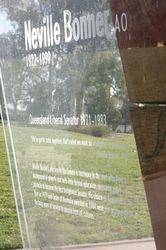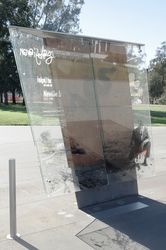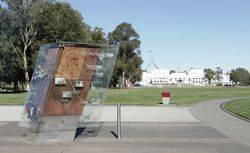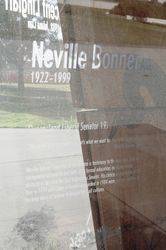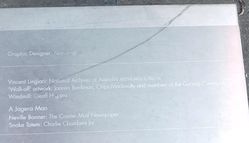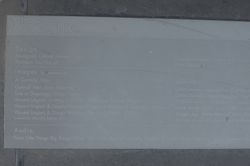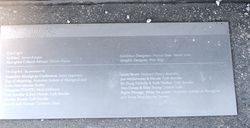
Home » Themes » People » Indigenous
Neville BonnerPrint Page 
The Leadership Artwork commemorates Neville Bonner who became the first Indigenous Senator in the Australian Parliament in 1971.
To celebrate Indigenous leadership, this artwork focuses on two Aboriginal men. Neville Bonner, a Jagera man, fought for his people 'within the system', and became the first Indigenous Senator in the Australian Parliament (1971). Vincent Lingiari, a Gurindji man, led his people in a walk-off at Wave Hill Station in the Northern Territory in 1966 which began the Aboriginal land rights movement in Australia.
The southern face of the artwork features an artist's representation of a carpet snake (Neville Bonner's totem) burnt into a redgum timber surface behind Bonner's image. The northern faces feature a timeline with images depicting significant events during the fifteen-year campaign for recognition of land rights.
The lower image on the north-eastern side was derived from the Gurindji Freedom Banner, a tapestry created by Gurindji women depicting the Wave Hill walk-off.
The featured song, 'From Little Things Big Things Grow', by Paul Kelly and Kev Carmody, tells the story of Wave Hill and Vincent Lingiari.
Neville Bonner was born on Ukerebagh Island on the Tweed River, New South Wales, in 1922. Like many Indigenous children of his age he had little formal schooling, leaving after he had attained the third grade at the age of fifteen. He worked as a rural labourer on properties across Queensland until 1946, when he commenced employment at the Palm Island Aboriginal settlement. He rose to the position of assistant settlement overseer on Palm Island.
In 1960 Bonner moved to Ipswich where he became associated with the One People Australia League (OPAL), a moderate Aboriginal rights organisation. He served as one of the league’s directors for several years and was the Queensland president in 1970. Following the 1967 referendum, which amended the constitution to give the Commonwealth government the power to make laws in relation to Aboriginals, Bonner joined the Liberal Party. In 1971 he became the first Aboriginal person to sit in the Commonwealth parliament when he was chosen to fill a vacancy in the Senate caused by the resignation of a Liberal senator for Queensland. He was subsequently returned at elections held in 1972, 1974, 1975 and 1980.
Neville Bonner became a well-known parliamentary figure during his years as a senator. He was never a serious contender for a place in the ministry of the McMahon (1971–72) or Fraser (1975–83) governments. However he was a respected commentator on Indigenous issues and served on numerous Senate and Parliamentary Committees. He also served as the parliamentary representative on the Council of the then Australian Institute of Aboriginal Studies (now the Australian Institute of Aboriginal and Torres Strait Islander Studies).
Dropped from one of the winnable positions on the Liberal Party ticket for the 1983 Senate election, Bonner resigned from the Party and contested the election as an independent. He narrowly missed retaining his seat. Neville Bonner continued to be a strong advocate for Indigenous rights until his death in 1999.
Location
| Address: | King Edward Terrace, Reconciliation Place, Parkes, 2600 |
|---|---|
| State: | ACT |
| Area: | AUS |
| GPS Coordinates: | Lat: -35.298532 Long: 149.133007 Note: GPS Coordinates are approximate. |
Details
| Monument Type: | Art |
|---|---|
| Monument Theme: | People |
| Sub-Theme: | Indigenous |
| Designer: | Sliver -Paul Barnett (architect), Marcus Bree, Benita Tunks (concept designers), Alan Vogt (graphic designer) |
| Link: | http://adbonline.anu.edu.au/adbonli… |
Dedication
| Approx. Monument Dedication Date: | 2004 |
|---|


